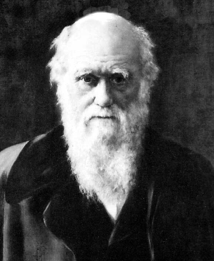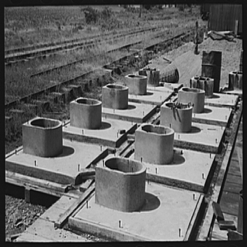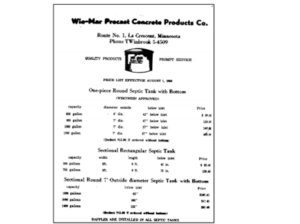The Evolution of Onsite Sewage Treatment

“The theory of natural selection is grounded on the belief that each new variety, and ultimately each new species, is produced and maintained by having some advantage over those with which it comes into competition; and the consequent extinction of the less-favored forms almost inevitably follows. . . Thus, the appearance of new forms and the disappearance of old forms, both those naturally and those artificially produced, are bound together. In flourishing groups, the number of new specific forms which have been produced within a given time has at some periods probably been greater than the number of the old specific forms which have been exterminated; but we know that species have not gone on indefinitely increasing, at least during the later geological epochs, so that, looking to later times, we may believe that the production of new forms has caused the extinction of about the same number of old forms.”
Excerpt from Chapter XI: On the Geological Succession of Organic Beings, The Origin of Species, by British Naturalist, Charles Darwin (1859)
In 1831, Charles Darwin embarked on a voyage to study life forms around the world. Darwin originally expected the trip to take two years. Five years later, he returned to England on the ship, HMS Beagle. Twenty-three years later, in 1859, he published his famous treatise, The Origin of Species. During those intervening years, Darwin refined his research into the revolutionary, scientific theory that new species with superior traits develop to challenge the existing species. Failure of the existing species to meet the challenges presented by their new rivals results in inevitable extinction of those failing to adapt to change.
While Darwin conducted his research, another Englishman, John Shaw, began documenting evidence of the great Cholera epidemics occurring in Europe during the 1840s and 1850s. From his research, Shaw, a London physician, noticed that Cholera breakouts occurred almost exclusively in areas with dense populations. Most scientists of that time believed that Cholera was an airborne disease. In 1859, Shaw proved his theory that Cholera was transmitted by water contaminated with human sewage. Shaw’s research resulted in the development of rudimentary sanitary regulations for protecting drinking water.
You might wonder what these two stories have in common other than the two prominent Englishmen being contemporaries of one another. It requires a bit of imagination to make the connection, but the stories do intertwine. Darwin’s theory teaches us that everything is subject to extinction if it fails to adapt to a changing environment. Shaw’s work resulted in the creation of the industry in which many of you make your livelihood — onsite wastewater treatment. The two stories intersect today in the development of onsite regulations which are changing the way the industry functions.
Precasters Failing to Adopt New Practices to Meet the Changing Environment Face Inevitable Extinction

Prior to the passage of the Clean Water Act of 1972, little attention was paid to the effect home sewage disposal had on local ground water. Homeowners and local health officials worried about septic tank effluent only if “black and stinky” liquid appeared in a basement or in a backyard. People knew enough to keep wells a safe distance from leach fields, but other than that not much else was of concern. Early septic tanks were made from concrete blocks, steel, redwood planks and the like. As the post-World War II housing boom occurred, precast concrete became the dominant material for septic tanks.
Many individuals involved in the installation of septic tanks did not see the need to worry about “structural integrity” and “watertightness” of system components, relying on the attitude “what does it matter if the sewage leaks out of the septic tank, the sh*@ goes in the ground over there (i.e., drainfield) anyway.” It became an accepted industry practice for tank installers to use a hammer to knock a hole in a tank (regardless of material the tank was made from) to eliminate the possibility of buoyancy if placed in areas with high groundwater.

Precast practices differed from today’s standards as evidenced by the copy of a Minnesota-based precaster’s 1960 price sheet. The price sheet states that the precaster would deduct $15.00 if his septic tank was ordered without a bottom. No one took soil evaluation into account other than to keep septic systems out of areas with a high-water table. Such was the nature of the industry prior to the Clean Water Act.
As more stringent regulations began to develop, the precast concrete industry became involved in technical associations such as the American Society of Testing and Materials (ASTM). ASTM Committee C-27 on Precast Concrete Products was formed in 1972. The precast industry itself first developed a standard covering precast concrete tank construction with the adoption of ASTM C-1227, Standard Specification for Precast Concrete Septic Tanks. The C-1227 specification covers design requirements, manufacturing practices, and performance requirements for precast concrete septic tanks. Today, most national and state onsite regulations cite C-1227 as THE authoritative standard covering precast concrete septic tanks.
Looking for information about ConSeal’s recommended specifications for septic tanks?

